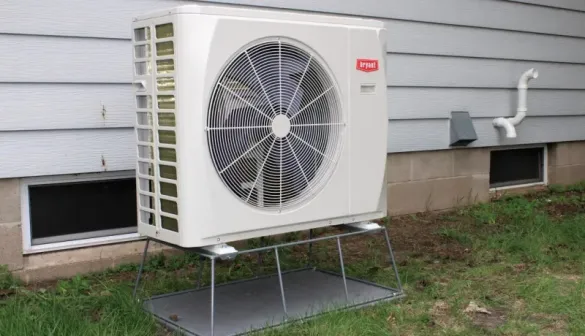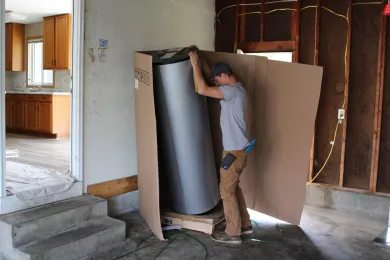Center for Energy and Environment (CEE) and the Minnesota ASHP Collaborative, alongside community partner Twin Cities Habitat for Humanity, received an EPA Grant to help increase the adoption of cold climate air source heat pumps (ASHPs) in new and existing homes. By better understanding the up-front cost, design challenges, and market potential of pairing ASHPs with ducted furnace systems, this project aims to accelerate decarbonization through the electrification of space heating.
Project Background

Beginning in August 2022, CEE, MN ASHP Collaborative, and Twin Cities Habitat for Humanity (TCHFH) developed a plan for energy modeling and HVAC system design of an existing home. Based on TCHFH’s interest in retrofitting existing homes with ASHPs, CEE helped familiarize TCHFH with heat pumps and identified scenarios where they could use ASHPs to electrify and decarbonize their existing homes.
This case study shows how an electric ASHP can pair well with an existing natural gas furnace to increase heating efficiency, while also adding a source of efficient cooling. While TCHFH consistently builds and retrofits homes for efficiency and airtightness, they had not yet incorporated ASHPs into their home designs. Since the home highlighted in this study was relatively airtight, the heating and cooling systems could be more easily optimized for energy efficiency.
By performing in-depth analysis and testing of this TCHFH home, we were able to understand the up-front costs and ongoing operational costs of pairing an electric ccASHP with an existing natural gas furnace. In this dual fuel setup, a ccASHP can be used as the primary heating and cooling system throughout the year. Because ASHPs are much more energy efficient than natural gas furnaces, they can be used for heating on all but a few of the coldest days of the year
Energy Analysis and Recommendations
In July 2022, CEE completed an initial on-site audit of the TCHFH home and created an energy profile and report of recommendations. The home tested was relatively airtight and its attic and walls adequately insulated, so CEE recommended pairing a ASHP with the existing 80% efficient gas furnace. Since the furnace was only two years old and in good condition, it was not recommended to be replaced. Additionally, the furnace already had an ECM (electronically commutated motor), allowing it to deliver heating and cooling much more efficiently when paired with the ASHP. This solution also added central air conditioning to the house, which it did not previously have.
Using the data from the energy audit, CEE generated a projected Home Energy Rating System (HERS) score of 93, representing the home’s current energy performance rating. CEE also modeled projected scenarios for various energy upgrades, including ASHP models and configurations as well as water heater types, to achieve TCHFH’s goal of HERS 80 or below (a lower HERS score being more efficient). This modeling included energy use and operating cost estimates to inform the ASHP bidding process and communications with HVAC installers.
Contractor Referral and Heat Pump Bidding Process

In this case, the electric utility, Dakota Electric, provided funding for the ASHP and heat pump water heater totaling $13,472, while offering key guidance on heat pump costs, contractor selection, and the appropriate electric rates and metering set up for the ASHP and heat pump water heater installed.
Throughout this project, TCHFH staff needed additional expertise with heat pump technology and support requesting and evaluating ASHP bids. CEE used program resources developed through the MN ASHP Collaborative to guide the TCHFH staff in their conversations with HVAC contractors familiar with ASHP installs.To help TCHFH find an ASHP model compatible with the existing furnace, CEE worked with a distributor connection to help understand the benefits and limitations of this pairing. CEE also reviewed and provided input on bid selection and worked with TCHFH to create a bid specification template for future ASHP projects.
Energy Modeling to Estimate Homeowner Costs
CEE used Ekotrope software to model energy costs for a baseline scenario (existing furnace and a federal minimum standard central air conditioner) and the post-retrofit scenario (existing furnace with upgraded appliances, including a dual fuel ASHP and heat pump water heater). We chose to model an air conditioner in our baseline scenario even though TCHFH does not typically install them, to account for the fact that homeowners often install air conditioners after purchasing the home, typically choosing an inexpensive and less energy efficient option. Overall, the models showed a decrease in projected annual energy use by 20% and a decrease in projected annual energy costs by 10%.
A key finding during the modeling process, was that the dual fuel ASHP was operating cost-neutral compared to the existing high efficiency gas furnace at current electric and natural gas rates. This is largely because of a favorable “controlled interruptible” rate offered by the home’s electric utility, Dakota Electric, allowing for selection of a lower economic switchover temperature (the degree at which heating switches from electric ASHP to secondary gas furnace) and a greater potential for carbon emission reductions due to the displacement of natural gas as the electric power sector becomes cleaner over time.¹
Under this rate structure, the utility offers a greatly reduced electric rate in exchange for the ability to switch from the dual fuel ASHP to the gas furnace via radio control to manage loads during times of peak demand. This type of rate is also sometimes referred to as a “dual fuel” or “off-peak” rate. In areas where this type of rate is offered, electric utilities ensure that ASHPs are installed with appropriate metering equipment and that homeowners are enrolled in these programs to help save energy. In addition to the electric rate benefits, a dual fuel ASHP offers fuel flexibility and resilience to the potential volatility of natural gas prices.² This dual fuel setup also allows homeowners to adjust the system’s switchover temperature to optimize savings as utility prices change.
Electrification and Carbon Emissions
The electrification work done on the home is projected to increase first-year carbon emissions due to the emissions from increased electric use. However, over the lifetime of the equipment, emissions are projected to decrease below baseline levels as Minnesota transitions to 100% carbon-free electricity by 2040.4 A detailed breakdown of energy consumption and energy costs by end use is below.
Energy Consumption Breakdown by End Use

Cost Breakdown by End Use

Total Emissions:

Rates assumptions: In the baseline scenario, all electric use was modeled using a seasonally weighted average of Dakota Electric Association’s standard residential electric rate ($0.1238/kWh, $0.1377/kWh June–September). In the post-retrofit scenario, heating, cooling, and water heating were modeled using the controlled interruptible rate ($0.0631/kWh). Natural gas use was modeled using CenterPoint Energy’s residential gas rate, including the base cost of gas and gas distribution charge. This rate does not include applicable riders and taxes, which can significantly increase monthly volumetric charges.
Final Inspection Testing
CEE completed final testing by inspecting the newly installed heat pumps to ensure the system was running properly while also collecting data on additional energy upgrades for the final HERS rating. To verify the HVAC upgrades, CEE collected model numbers and confirmed the thermostat settings for ASHP switchover temps and functionality while noting any additional upgrades (fridge, stove, kitchen hood) that may affect the final HERS score. A TCHFH supervisor met CEE staff on-site to discuss the thermostat settings and ensure all HVAC equipment was running correctly. A final HERS model was then created to include all energy upgrades made within the house, achieving an estimated post-HERS score of 77 and meeting TCHFH’s goal of HERS 80 or below.
Key Takeaways
- The first step for homeowners looking to improve the efficiency of their home is to focus on airtightness and insulation while monitoring, maintaining, and updating HVAC systems. A home energy audit can help assess and prioritize which energy-related improvements are beneficial and cost-effective. If air sealing, insulation, or HVAC work is needed, it is important to work with a reputable and rebate-eligible contractor.
- Once a home is airtight and well insulated, an ASHP can be a useful way to add efficient heating and cooling while meeting electrification goals and achieving carbon reduction over time. With favorable dual electric fuel rates, utility rebates, and federal tax incentives; it is advantageous to add an ASHP as the primary heating and cooling source to pair with an existing natural gas furnace as backup heat on the coldest few days of the year.
- Electric utilities and third-party organizations provide useful resources and guidance to homeowners through the HVAC contractor selection and ASHP bidding process.
- HVAC contractors who work directly with distributors can get equipment and training support for high-quality installation of heat pumps in our climate.
Habitat Rehab Home Energy Profile
- Where: Rosemount, MN
- Built: 1968
- Size: 2240 ft²
- Number of Bedrooms: 3
- House Type: Rambler
- Insulation: R40(attic),R11(sidewalls), and R15 (rim joists)–weatherized by local CAP in 2011
- Primary Heating System: 80% efficient centrally ducted natural gas furnace with ECM motor (installed in 2020)
- Primary Cooling System: None
- Water Heating: Natural draft gas water heater (installed in 1996)
- House Tightness: 957 CFM50 (or 3.2 ACH50)
- HERS Model Score: 93 (TCHFH goal is 80 or below for rehabs)
Audit Recommendations & Improvements
- Dual fuel setup pairing electric ccASHP (to use as primary heating and cooling) with existing two-year old ducted gas furnace (to use as backup heat at 25°F or below)
- Replace 26-year-old water heater with heat pump water heater to add electrification and future decarbonization
- HERS score from 93 to 77 projected after ccASHP and heat pump water heater upgrades
-
Projected 37% decrease in natural gas usage (from 848 to 642 therms)
Air Source Heat Pump Specifications
- Variable-speed, 3 tons, 16 SEER2, 8.5 HSPF2, 2.26 rated COP @ 5°F
- Capacity Balance Point: 25°F Heating Design Load: 37k Btu/hour (at -11°F) *based off Manual J
- Cooling Design Load: 13k Btu/hour (at 89°F) *based off ASHRAE
Appendix
Northeast Energy Efficiency Partnerships (NEEP)
The NEEP cold climate ASHP product list can be used to look up extended performance data for ASHPs that can operate efficiently in cold climates. The tool also allows users to visualize heat pump performance data and find a heat pump’s capacity balance point in the Sizing for Heating tool using local weather data if heating design temperature and design load are known.
• Size for Heating User Guide provides detailed instructions for using the Sizing for Heating tool.
• Guide to Sizing & Selecting ASHPs in Cold Climates provides information on sizing and selecting ASHPs for different application types in cold climates.
The Minnesota ASHP Collaborative was formed in 2019 by Center for Energy and Environment and is a joint effort with Minnesota Utilities to promote ASHP adoption across Minnesota. We offer several resources that can be leveraged by builders looking to include ASHPs in homes they construct.
• Installation Best Practices Guide
• Cost of Heat Comparison tool models annual energy costs with various heat pump configurations for both natural gas and propane systems across several Minnesota utilities.
• Specification Summary Guide can be used to compare different ASHP equipment specifications. This can be useful during product selection to maximize available incentive funding.
• Online Trainings Modules cover heat pump potential in MN, heat pump sizing and selection, and installation best practices.
• Incentives and Financing lists available rebates and incentives for ASHPs in MN.
• Preferred Contractor Network lists contractors that have completed required training, undergone review of an ASHP installation to verify alignment with best practices, and are properly insured.
The Building Science Education Center provides many free resources and on-demand trainings on ASHPs.
• Introduction to Heat Pumps is an introductory training module on the basics of ASHPs.
• Smart Diagnostic Tools provides resources for high-quality installation of HVAC systems.